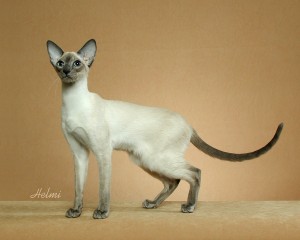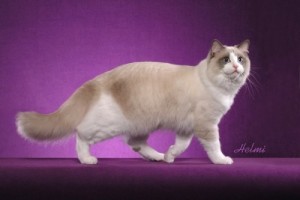Cat body types vary significantly. In the cat fancy, a cat’s shape or conformation is referred to in the breed standards in a particular way.
There are in fact a limitless number of body types. They can, however, be placed into 6 categories. This categorization is almost arbitrary but useful nonetheless.
All the photos and text on this page are protected by copyright except where indicated. Violations of copyright are reported to Google.com (DMCA). Sorry about that but needs must.
Here they are:
Oriental
This refers to a slender body; some would say skinny to use a term employed to describe people. On a more technical level, the head is long and triangular, the body is long and lean, the tail is long and so are the legs. Cats in this category are, for example, the Cornish Rex, Modern Siamese (the Cat Fanciers Association – CFA – would call this, simply, the Siamese), Balinese (long haired Modern Siamese), Oriental Shorthair and Oriental Longhair.
Here is an example of the oriental cat body type:

Modern Siamese – photo copyright Helmi Flick
Foreign
Again this refers to a slightly slender cat. Perhaps a better description would be athletic, although this is my description. Once again trying to be more technical and hopefully not confusing the body should be long and the legs in proportion and slim with fine boning. The tail should be long too and tapered. While the head should be a modified wedge. The ears should be large while the eyes are almond or oval shaped. Breeds in this category are the Abyssinian, Somali (long haired Abyssinian), Japanese Bobtail, Japanese Bobtail Longhair, Russian Blue, Nebelung and Turkish Angora.
Here is an example of the foreign cat body type:

Abyssinian – photo copyright Helmi Flick
Semi-Foreign
The semi-foreign cat body type describes a cat that is a little less slender or more thick set than cats with a foreign body conformation. It is a variation of the foreign type. The lines should be long and boning medium. That is probably obvious. For me, cats in this category are in the middle range of body conformation, very much standard cat shapes. Breeds described as semi-foreign would be the American Curl, American Curl Shorthair, Devon Rex, Egyptian Mau, Havana Brown, LaPerm, Munchkin (the body is normal but the legs are short giving the impression of being more cobby (see below) in my opinion, Tonkinese, Sphynx (this cat has a slightly odd body shape with a substantial body but limbs that look thinner in comparison) and Snowshoe cats.
Here is an example of the semi-foreign cat body type:

Havana Brown – photo copyright Helmi Flick
Semi-Cobby
We have passed through the mid point and are now heading towards the rounded/stocky/chunky end of the spectrum of cat body types. These are my words and not cat fancy words, of course. Types of cats that are considered to have this body conformation would be the American Shorthair, American Wirehair, Bombay, British Shorthair, Chartreux, Korat, Scottish Fold, Selkirk Rex and Singapura (I’d place the Singapura as in between semi-cobby and semi-foreign). In fact, it perhaps goes without saying that individual cats of many cat breeds will cross over to other types of cats in terms of body shape. The boundaries are not rigidly defined.
Here is an example of the semi-cobby cat body type:

Brit SH Cat – photo copyright Helmi Flick
See the Singapura Breed Standard to see how the CFA standard describes this well balanced cat.
Cobby
The body should be short and compact. The shoulders are broad. The head is rounded and the tail usually short. These are thick set cats, rounded cat breeds, are the type of cats that fall into this category and include: Burmese (this would refer to the USA type, the UK Burmese cat shape is different (see European Burmese, which is more Oriental in shape), Manx, Cymric (long haired Manx), Persian, Himalayan (pointed Persian) and Exotic Shorthair (shorthaired Persian).
Here is an example of the cobby body type:

Manx Cat – photo copyright Helmi Flick
See the Manx Cat Breed Standard to see how the cobby body fits in with the rest of the body and the CFA breed standard.
Substantial
These are simply large cats that are not rounded or stocky (cobby) and include the Maine Coon (one of the largest domestic cat breeds), Bengal (this cat can be a little smaller than substantial, sometimes, in my view), Birman, Norwegian Forest Cat, Pixiebob, Ragdoll, Siberian and Turkish Van.
Here is an example of the substantial body type:

Ragdoll – photo copyright Helmi Flick
The cats listed are a selection. There are many more cat breeds, albeit that some are on the fringes of the cat fancy (see domestic cat breeds for what I call fringe breeds). Start here: Photos of cat breeds A-H to see the more established breeds (this lead to two more pages of pictures of breeds).
Comment: A visitor made the following comment on cat body types. Make of it what you will:
Re “foreign type”, “semi- foreign type” and “oriental type”
In what I have seen in breed standards, the long, “tubular” body style and fine boning of a modern style Siamese or Oriental Shorthair is now called “oriental type” in the cat fancy.
The term “foreign type” was used long ago to describe the early Siamese and is now appropriately used in the standard for the TICA Thai (Old Style Siamese) – a noticeably long body but not so tubular and stretchy as the modern meezers and OS. The Russian Blue is another one described as “foreign type”
The Tonkinese, for example, is described as “semi-foreign type”.


Thanks for stopping and sharing. Yes, the post was written around 15 years ago. Over its lifetime it got a lot of hits. But AI has all but wiped out many sites and the latest algorithm change was brutal. I am almost at the end of my work on this site which is 17 years old.